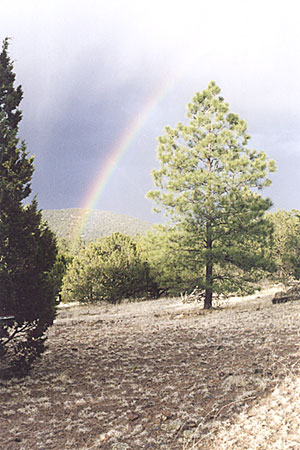Anasazi-Mogollon Frontier - Passport in Time
Main menu:
Previous Projects > States M-R
Pit Houses and Pueblos on the Anasazi-Mogollon Frontier
Cibola National Forest, New Mexico, 2000
by Chris Reed, PIT Volunteer
Here is a reflection of a week in central New Mexico. PIT provided me an opportunity to work with FS archaeologists and other volunteers to survey and record where two ancient cultures blended together in one environment. My fellow volunteers—Sheila Brewer, Karen Clouse, Orville Daniels, Jack Fisher, George Leighton, Marilyn Markel, Betsy Potter Reeves, Steve Reeves, and Tom Sholes—were a blend from as far as Montana and Kentucky, as well as from Colorado and New Mexico.
 Prior to going, I wondered what the area was like. During my last flight from Phoenix to Albuquerque, I looked out at the environment in which I would spend a week. It looked so barren, with mostly dirt, mesas, and washes. My thought was, How could anyone live on this land?
Prior to going, I wondered what the area was like. During my last flight from Phoenix to Albuquerque, I looked out at the environment in which I would spend a week. It looked so barren, with mostly dirt, mesas, and washes. My thought was, How could anyone live on this land?With map and instructions, the route to the project area was easy to follow. After the last miles of a rocky and rutted forest road, I was glad to see the PIT banner hanging on a tree. I still wonder how Orville brought his travel trailer in on that road. The project area is located on several low ridges, with sandy, grassy flat areas in between. I like the term “pinyon-juniper savannah.” After spending some time here, I realized that what I previously thought was barren land would be ideal for hunting, gathering, and farming.
With camp set up, I went for a walk. I sat on a rock and watched a herd of eight elk, who watched me as well. One stood guard, while the others continued to munch on the grass. Then, suddenly, all of them sprinted off as if I had shot a gun. It sounded like a stampede.
To survey the ridge, a group of 6–8 of us would walk 15 m apart, trying to stay parallel. The intent was to find anything of significance—for example, rock walls, sherd scatters, rubble mounds. A site survey consisted of counting and identifying the types of lithic materials and broken pottery, along with mapping the locations of the rubble mounds and room blocks. I enjoyed surveying, because it provided time to see the details of a site.
I spent most of the week on Owl Ridge. While we were surveying, someone observed an owl in flight. I now know the derivation of the name. Someone will have a good time trying to determine the reason for the name “Forbidden Ridge.”
At the eastern edge of Owl Ridge was a prominent site with more than 100 sherds, mostly brown ware and black-on-white. After counting and classifying the pottery, I was asked to identify the dominant type of black-on-white. I could identify the general type but not the specific type needed to date the site. Most of the sites were occupied between A.D. 1000 and 1300. The most interesting find was two fragments of a “paint pot.” The two fragments were found 17.5 m apart. The clay pot was 1–1½ inches tall. The red pigment on the clay looked like the deposit one would see after paint dried in a container.
And there was the contemporary pottery made by Steve. With some beige dirt and water, he formed the clay into small pieces of pottery. He put it in a can and placed it in the evening campfire. The heat had to exceed 1,100°F. The pottery turned into gray ware. He explained that he must take his artwork out of the forest so as not to contaminate the dating of the area.
We all came together in the evening with a campfire. I am glad Cliff (Magdalena District Archaeologist Cliff Nicoll) knew how to build a “friendly” fire, knowing now the tragedy that occurred a few days later in Los Alamos. On the first evening, each of us told the group how we had become interested in archaeology. I got to ramble on about adventure, outdoor activity, and a balance in life. At about 8:45 each night, a military jet would streak by low to the ground, and the topics of our conversations would change. On Wednesday, we were treated to a fully catered fajita dinner with real ceramic plates. Be coming involved with the history of the project, we had an atlatl-throwing contest, with some green trucks serving as the targets.
On the last night, Tom (FS Archaeologist Tom Cartledge) finally got a string for his guitar and played a campfire concert of vintage country western music. Jack commented, “Good fire, good concert, and good friends.” As I stared into the fire and then looked up to the stars, those simple comments reflected this experience.